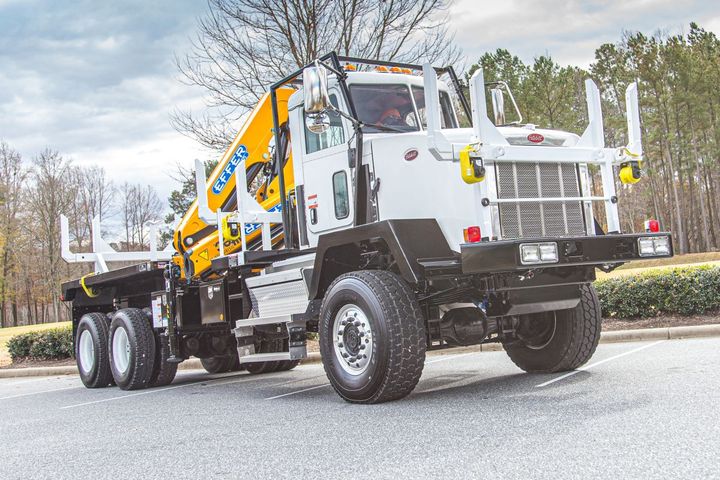Fleet managers can benefit from paying attention to current trends related to truck and van upfits in 2020. Photo: Fontaine Modification
Vocational work truck and van fleets often use traditional trucks or vans, upfit with a variety of specialized equipment to help them accomplish their tasks safely. Trends related to these upfit products and the upfit process can have a significant impact on new and replacement fleet orders.
Trend 1: Varying Lead Times
Varying lead times and ship-thru dates are trends that have made a more substantial appearance in the past year.
“With what is currently going on in the world, longer lead times have been greatly affected by the lack of chassis availability. OEM ship-thru lead times continue to be a big sticking point for customers. This is often referred to as a ‘black hole’ when it comes to finding out when you will get your vehicle once it leaves the upfitter,” said Chris Rolsen, national business development manager at Knapheide.
Another trend closely monitored is the time for bodies and components.
“For the most part, manufacturers have done a tremendous job of creating efficiencies in their production processes. Many of the industry’s top manufacturers have expanded their production and now have dedicated production lines for their most popular bodies and components. They’re being much more strategic about their processes to meet demand better and should be commended for these efforts,” said Kelly Klemisch, regional engineering manager, Holman Enterprises.
Nate Eichinger, director of operations, Light Duty Truck and EV Solutions for Fontaine Modification, noted that, in general, lead times from OEMs had decreased dramatically over the past 12 months.
“2019 was a wild year, with record orders and builds; however, even before the COVID-19 outbreak, orders have reigned into more reasonable time frames. The global pandemic has impacted everyone, both on a personal and business level,” Eichinger added.
A final impact on overall OTD is directly connected to the fleet itself.
“Many companies, while they do plan for purchases, tend to procrastinate on making those purchases. Because of a compressed timeline, everything ends up being based on availability. Fleets are looking for speed to market in the delivery process. This leads to the pressure being on the upfitter now, and they’re becoming more incentivized to be fast. There’s a significant amount of pressure that goes onto the suppliers because everyone is now on an adjusted-time delivery market. The manufacturer doesn’t want to bring excess inventory in, the assembly or the upfitter doesn’t have room or the working capital to tie up in products sitting around waiting on a vehicle, changing everything to a model that is very speed-to-market driven,” said Craig Bonham, vice president of commercial vehicle at Safe Fleet.
Trend 2: A Focus on Safety
We all know that driver and worker safety is top of mind for fleets.
“The fleet needs to be part of the safety solution. It’s a fact that service vehicle fleets are the No. 1 type of fleet for injuries. Fleet managers need to factor driver/worker safety into their upfits. The vehicles continue to provide additional safety equipment. Well, so do upfits,” said Jeff Haag, VP of fleet sales for DECKED.
Trend 3: Increased Green Transportation
There is a greater push for ‘green’ transportation with full battery-electric and hybrid systems gaining a lot of attention. “Fontaine created a new division, Light Truck and EV Solutions, in January 2020 to focus directly on these emerging technologies and understand their place in the commercial trucking landscape,” said Eichinger of Fontaine Modification.
Trend 4: Shift in Vehicle Preferences
There has also been a noticeable shift in preference toward commercial vans in vocational applications.
“There are certainly many scenarios where a fleet stands to benefit by allowing their service technicians to work in a covered area. Today’s van offerings can accommodate a limitless number of upfit configurations that help to increase productivity. And, the economics involved means there’s virtually no change in initial capital outlay or pricing structure, ensuring fleet operators have the ideal unit for the job with minimal, if any, cost ramifications,” said Klemisch of Holman Enterprises.
Trend 5: Lightweight and Eye Pleasing
Finally, Mathew Marcussen, director of customer relations for BrandFX, said, “We are seeing the push for a quality product that is durable, lightweight, and aesthetically pleasing.”
What trends are you seeing related to upfits? Did I miss anything? E-mail me, let’s chat!
Lauren Fletcher, Executive Editor
Lauren.Fletcher@bobit.com
Author
Executive Editor
Source: https://www.worktruckonline.com/
CUT COTS OF THE FLEET WITH OUR AUDIT PROGRAM
The audit is a key tool to know the overall status and provide the analysis, the assessment, the advice, the suggestions and the actions to take in order to cut costs and increase the efficiency and efficacy of the fleet. We propose the following fleet management audit.





